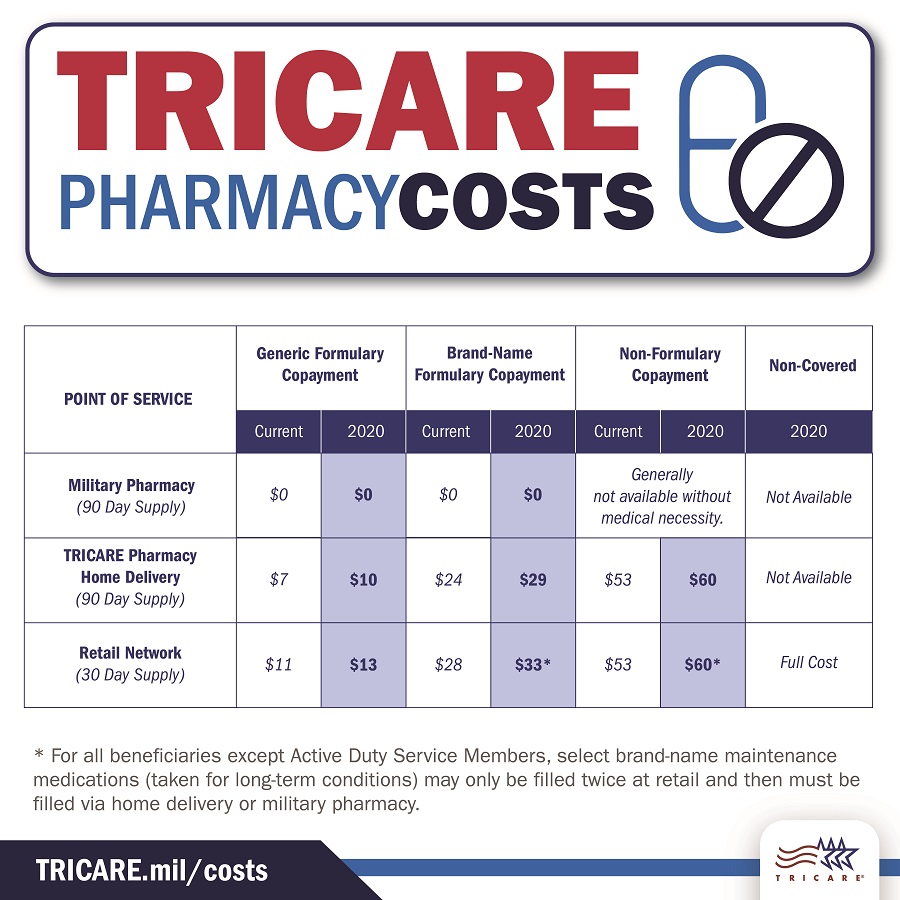With a new year comes big shifts and switches. Our military healthcare is no different. Make sure that you’re tracking all of Tricare’s 2020 changes!
Are You Tracking Tricare’s 2020 Changes?
The new year is bringing changes to covered benefits and services, pharmacy options and more. You’ll want to double-check your specific plan to make sure you’re covered for the healthcare you need.
Tricare Pharmacy CoPayments Change in 2020
If you’ve filled a prescription this year, you might have noticed that the price jumped up a bit compared to 2019. That’s because it has.
Effective January 1, Tricare updated its copay cost-share for beneficiaries. Here’s the breakdown:
- Military Treatment Facility (MTF): no changes to current plan
- All Active Duty Service Members: no cost at MTF or network pharmacies
Tricare Pharmacy Home Delivery: 90 day supply
- Generic Formulary: 2019 rate – $7; 2020 rate – $10
- Brand-Name Formulary: 2019 rate – $24; 2020 rate – $29
- Non-Formulary: 2019 rate – $53; 2020 rate – $60
- Non-Covered: not available
Retail Pharmacy: 30 day supply
- Generic Formulary: 2019 rate – $11; 2020 rate – $13
- Brand-Name Formulary*: 2019 rate – $28; 2020 rate – $33
- Non-Formulary*: 2019 rate – $53; 2020 rate – $60
- Non-Covered: full cost
*Note: brand-name and non-formulary prescriptions can only be filled twice via retail network pharmacies; following this they must be filled at an MTF or via Tricare Pharmacy Home Delivery.

Make Early Breast Cancer Detection Easier with New Covered Screening
Starting January 1, Tricare has expanded access to preventative breast cancer screening measures to more female beneficiaries. More women can now be screened for breast cancer with an annual 3D mammogram.
Previously, this option was only available for patients deemed “at risk.” All other patients received a 2D mammogram by default.
This change comes in response to ongoing research and data about breast cancer from the American Cancer Society. Currently, 1 in 10 American women will be diagnosed with breast cancer in her lifetime. This makes it the second most prevalent cancer among women, coming after skin cancers.
While coverage has expanded significantly, 3D mammograms will not be standard practice for every female Tricare beneficiary.
In order to receive a 3D mammogram, you must meet one of the following criteria:
- Age 40 or older
- Age 30 or older with high-risk factors; have a 15% or greater likelihood of breast cancer occurring
This new cancer screening option is covered under the Provisional Coverage Program. This Tricare program covers the cost of certain new or developing medical procedures and medications as part of a clinical trial or study.
Tricare can extend the coverage of this option for up to 5 years. At that time, Tricare will review their data to determine if the program should become a covered benefit.
More Provisional Coverage Programs You Should Know
It’s not just 3D mammograms that are being covered by the PCP. There is also a new treatment for osteoarthritis of the knee and tennis elbow being piloted.
If you have a diagnosis of mild to moderate chronic osteoarthritis of the knee or lateral epicondylitis, also known as “tennis elbow,” you might qualify for this new treatment.
Speak to your PCM to discuss treatment options if you meet the above criteria.
Picking a Tricare Plan for Your Family
When considering changing your Tricare plan(s), there are a few things you should be aware of:
- Changes can typically only be made during open enrollment season, which typically falls between October and November
- Changes can also be made for a qualifying life event, such as retiring, PCSing, marriage or adding a child to your family
Before committing to a Tricare plan, it is advised that you consider their plan comparison tool. This helps beneficiaries better understand out of pocket costs, if any, as well as where they can access care.
Beneficiaries can also use an interactive Tricare Plan Finder. This online quiz determines your current benefit status and healthcare needs, as well as plans available in your current location.
It is important that you understand all the different programs and options for care available to you in order to make an informed decision about your health.
.jpg)
